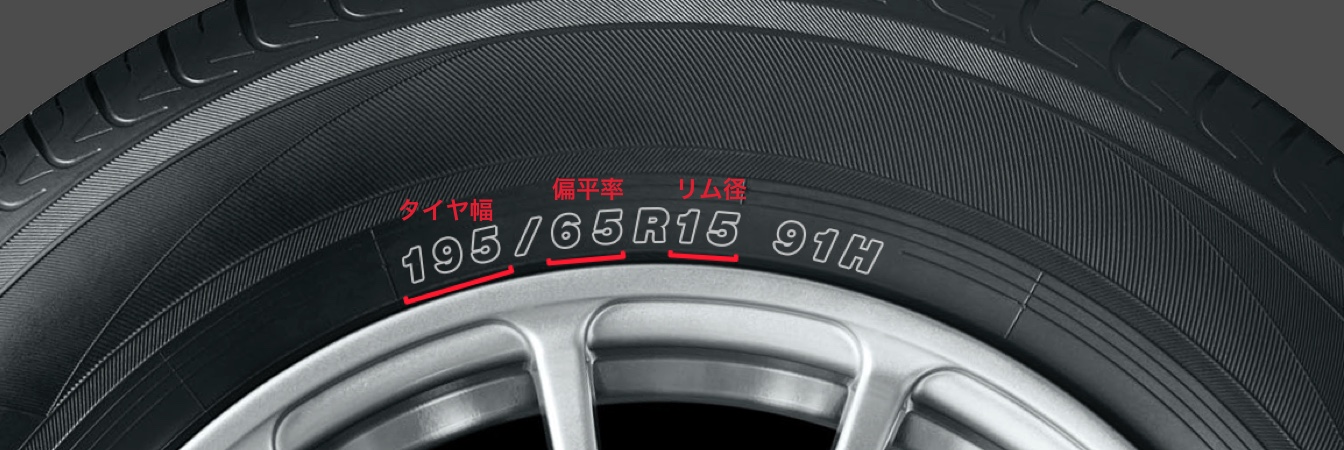Yokohama India - Tread
Yokohama India - Tread
Center wear
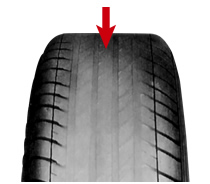
- Examples
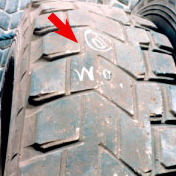
- Condition of damage
-
The center of tread wearing faster than the shoulders
- Causes
-
- 1. Overinflation
- 2. Improper matching of tyres and rims
- 3. Tyres are not rotated timely
- Recommendations
-
- 1. Use tyres under the recommended air pressure
- 2. Use proper rims
- 3. Rotate tyres timely before center wear becomes serious.
Tread – Shoulder Wear
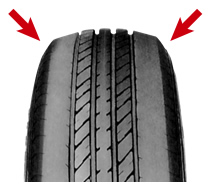
- Examples
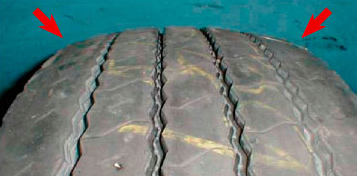
- Condition of damage
-
Both shoulders wearing faster than the center tread
- Causes
-
- 1. Underinflation and / or overload
- 2. Repeated sharp turns at a high speed in cornering
- 3. Improper matching of tires and rims
- 4. Tyres are not rotated timely
- Recommendations
-
- 1. Use tyres under the recommended air pressure
- 2. Avoid rough driving in cornering
- 3. Use proper rims and mount tyres properly
- 4. Rotate tyres timely before shoulder wear becomes serious
Tread – One-sided Wear
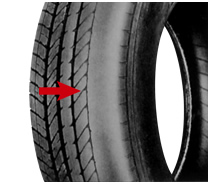
- Examples
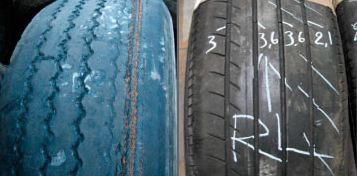
- Condition of damage
-
One side of tread wearing unusually fast
- Causes
-
- 1. improper wheel alignment (especially faulty camber)
- 2. Overload
- 3. Frequent use on high crown roads
- Recommendations
-
- 1. Adjust wheel alignment correctly
- 2. Rotate tyres timely before one-sided wear becomes serious
- 3. Avoid overload
- 4. Remount tyres conversely
Tread – Feather Edge Wear
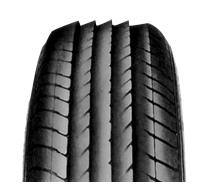
- Examples
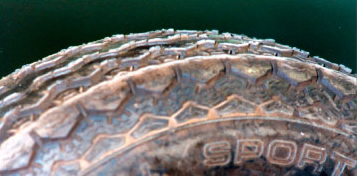
- Condition of damage
-
The blocks or the ribs of tread wearing in a feather edge pattern
- Causes
-
- 1. Improper wheel alignment (especially faulty toe-in)
- 2. Bent axle beam
- 3. Frequent use on high crown roads
- Recommendations
-
- 1. Adjust wheel alignment correctly
- 2. Adjust mechanical faults correctly
Tread – Heel And Toe Wear
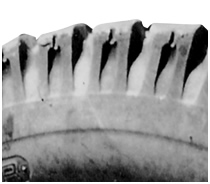
- Examples
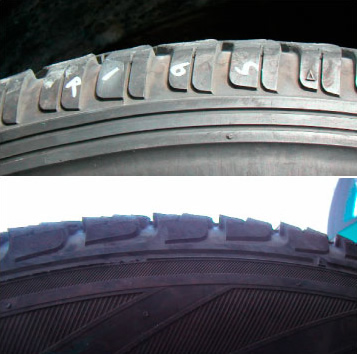
- Condition of damage
-
One side of the blocks and / or lugs on the tread wearing faster than the other side circumferentially like sawteeth
- Causes
-
- 1. Tyres are not rotated timely
- 2. Underinflation and / or overload
- 3. Sudden braking or rapid acceleration
- Recommendations
-
- 1. Rotate tyres timely before heel & toe wear becomes serious
- 2. Use tire under proper air pressure and load
- 3. Avoid rough driving
Tread – Spot Wear
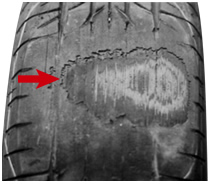
- Examples

- Condition of damage
-
Patches of excessive wear occurring at intervals around the circumference
- Causes
-
- 1. Faulty suspensions, faulty rotating parts and / or brake parts such as axle beams, bearings and brake shoes
- 2. Dynamic imbalance of tyre and rim assembly
- 3. Excessive run-out of tyre and rim assembly
- 4. Sudden braking or rapid starting
- 5. Underinflation and / or overload
- Recommendations
-
- 1. Avoid rough driving
- 2. Repair the mechanical parts such as faulty suspension,axle beams, bearing and brake shoes
- 3. Minimize the run-out of tyre and rim assembly by matching the maximum run-out point of tyre to minimum run-out point of rim
- 4. Adjust the dynamic imbalance of tyre and rim assembly with a wheel balancer
Sidewall – Bleeding CBU

- Examples
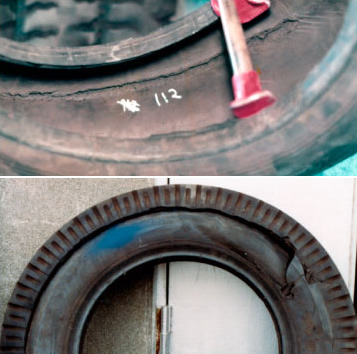
- Condition of damage
-
Carcass cords are broken up circumferentially at shoulder or sidewall in a line or a saw pattern
- Causes
-
- Excessive heat generation and fatigue caused by gradual leakage of air due to:
- 1. Unmatched valve core or aged core rubber
- 2. Fine materials such as mud or dust in the valve
- 3. Pin hole (small puncture) or tire and/or tube
- 4. Rust or any fine materials on the bead seat of rim
- 5. Unsatisfactory repair of puncture
- Recommendations
-
- Stop to use the damaged tyre
- 1. Use tyres under the recommended air pressure and load, and check the air pressure periodically
- 2. Use a correct, new valve core
- 3. Use a valve cap to avoid entry of fine materials
- 4. Use new tubes for new tyres
- 5. Remove rust or fine materials from the bead seat of rims when tyres are mounted
- 6. Repair punctured tyres and/or tubes correctly
Sidewall – CBU Due To Cut Or Shock

- Examples
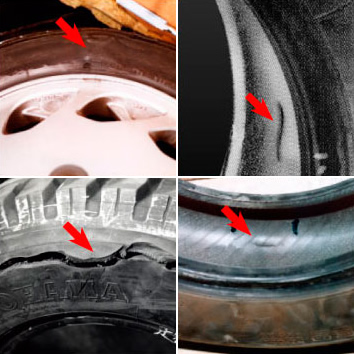
- Condition of damage
-
Carcass cords are broken up at shoulder and / or sidewall
- Causes
-
- 1. Bad distortion or pinching between object and wheel(tyre)
- 2. Hard hit against the object
- 3. Low inflation pressure
- 4. Low aspect ratio tire is more likely to get CBU
- Recommendations
-
- Stop to use the damaged tyre
- 1. Drive carefully to avoid obstacles. If the obstacles cannot be avoided, reduce the speed
- 2. Check tyres frequently, and remove foreign materials between the duals
- 3. Use tyres under the recommended air pressure and load
Sidewall – Runflat
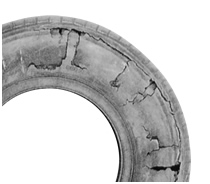
- Examples
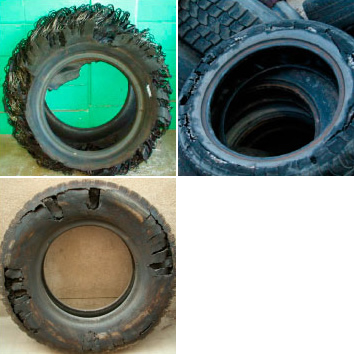
- Condition of damage
-
Normally, the tyre sidewall is severely damaged as in the picture shown on the right. In the case of bias tyres(cross-ply tires), the inner carcass cords may separate and may be exposed on the surface
- Causes
-
- 1. Continuous running after puncture
- 2. Excessive underinflation(close to a flat condition)
- Recommendations
-
- Stop to use the damaged tyre
- 1. Stop the vehicles as soon as a flat tire is aware of, and change the flat tire to spare tire immediately
- 2. Check air pressure frequently
- 3. Check any nails imbedded in tread or other external damage frequently
Bead – Rim cut and injury
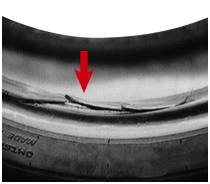
- Examples
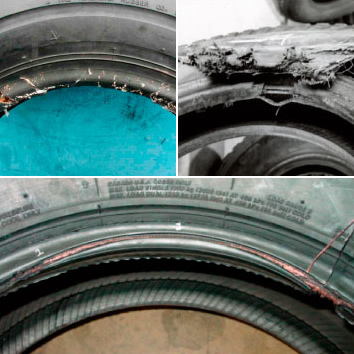
- Condition of damage
-
Rim cut and injury
- Causes
-
- 1. Faulty (deformed, rusted, etc.) rims or wrong size of rims
- 2. Careless mounting/dismounting (omission of lubricant such as soapy water on bead, mishandling of tyre
Handling – Vibration
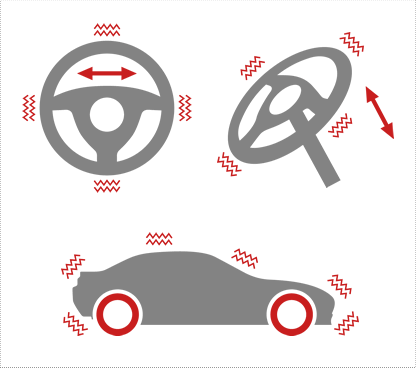
- Condition of damage
-
Car body or steering wheel vibrates vertically or laterally. Such vibrations normally occur at speeds of about 80km/h or more.
- Causes
-
- 1. Imbalance of tyre-rim assembly
- 2. Excessive run-out of tyre-rim assembly
- 3. Improper mounting of tyres on rims
- 4. Abnormal wear such as spot wear, wavy wear, heel & toe wear, etc
- 5. Faulty steering parts, joints, shock absorber, etc.
- Recommendations
-
- Consult your car/tyre dealer
- 1. Throughly adjust the imbalance of tyre-rim assembly
- 2. Mount tyres on rims properly
- 3. If abnormal wear is found, rotate the tyres
- 4. Repair the mechanical parts such as faulty steering parts, joints, shock absober, etc.

